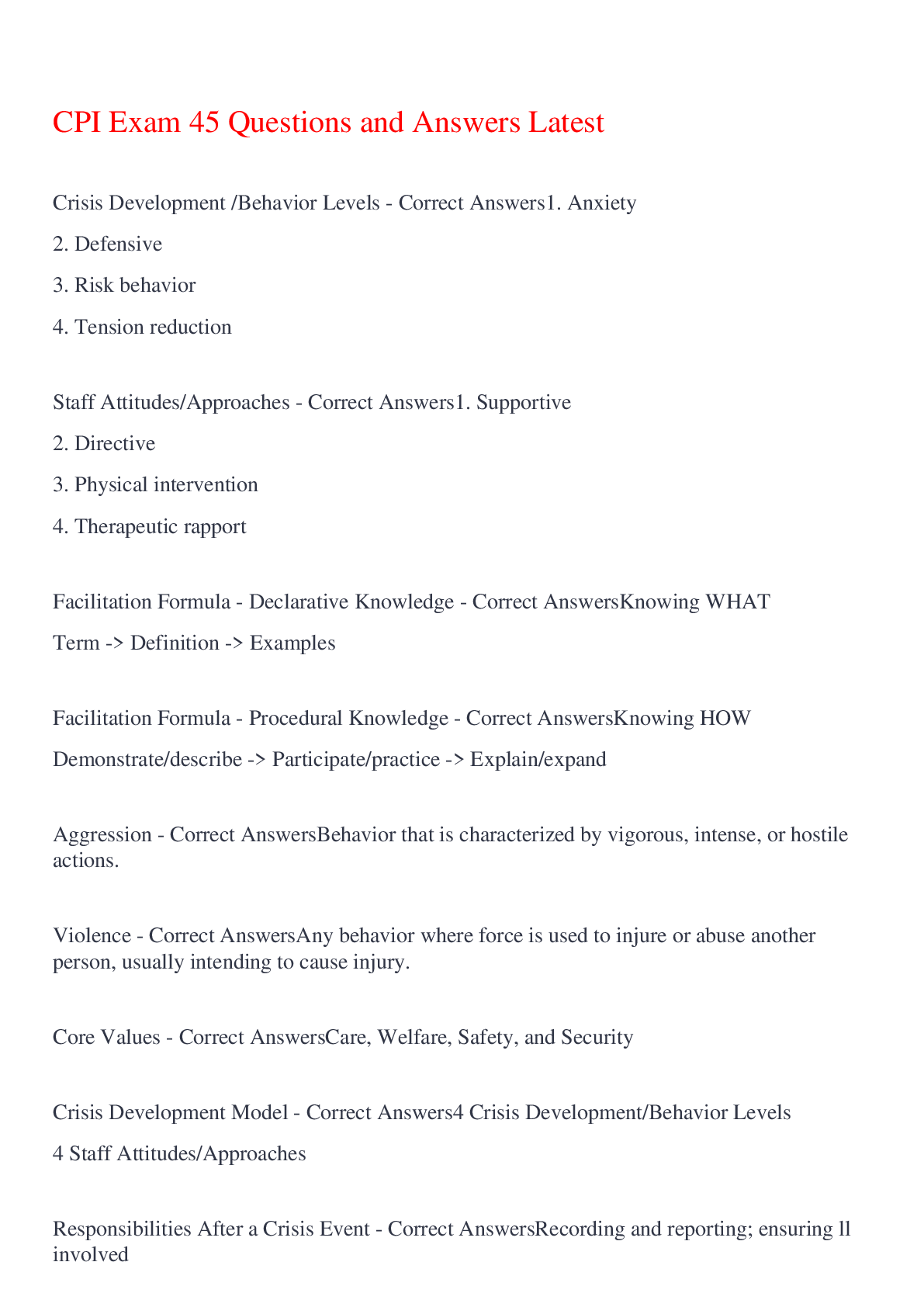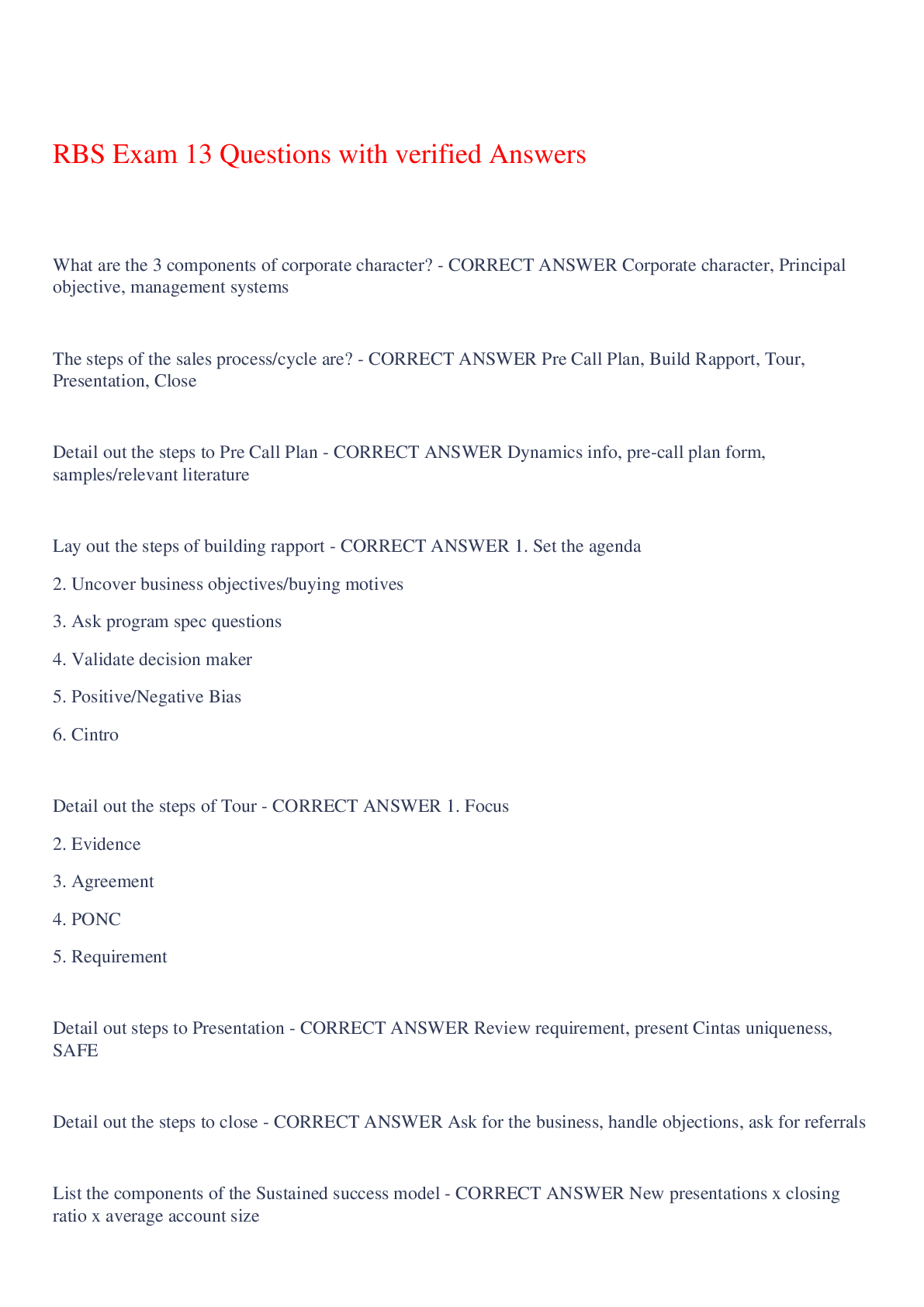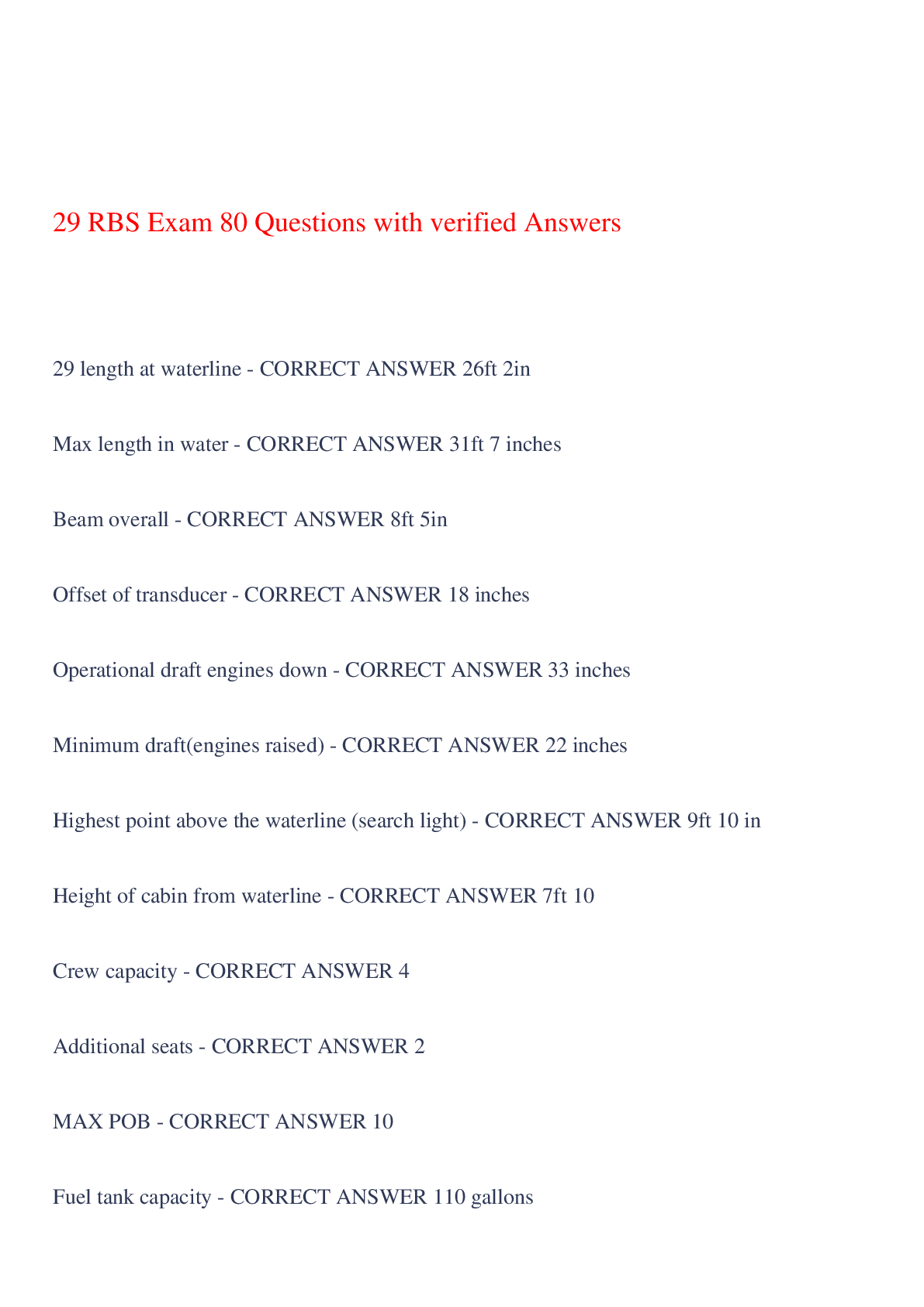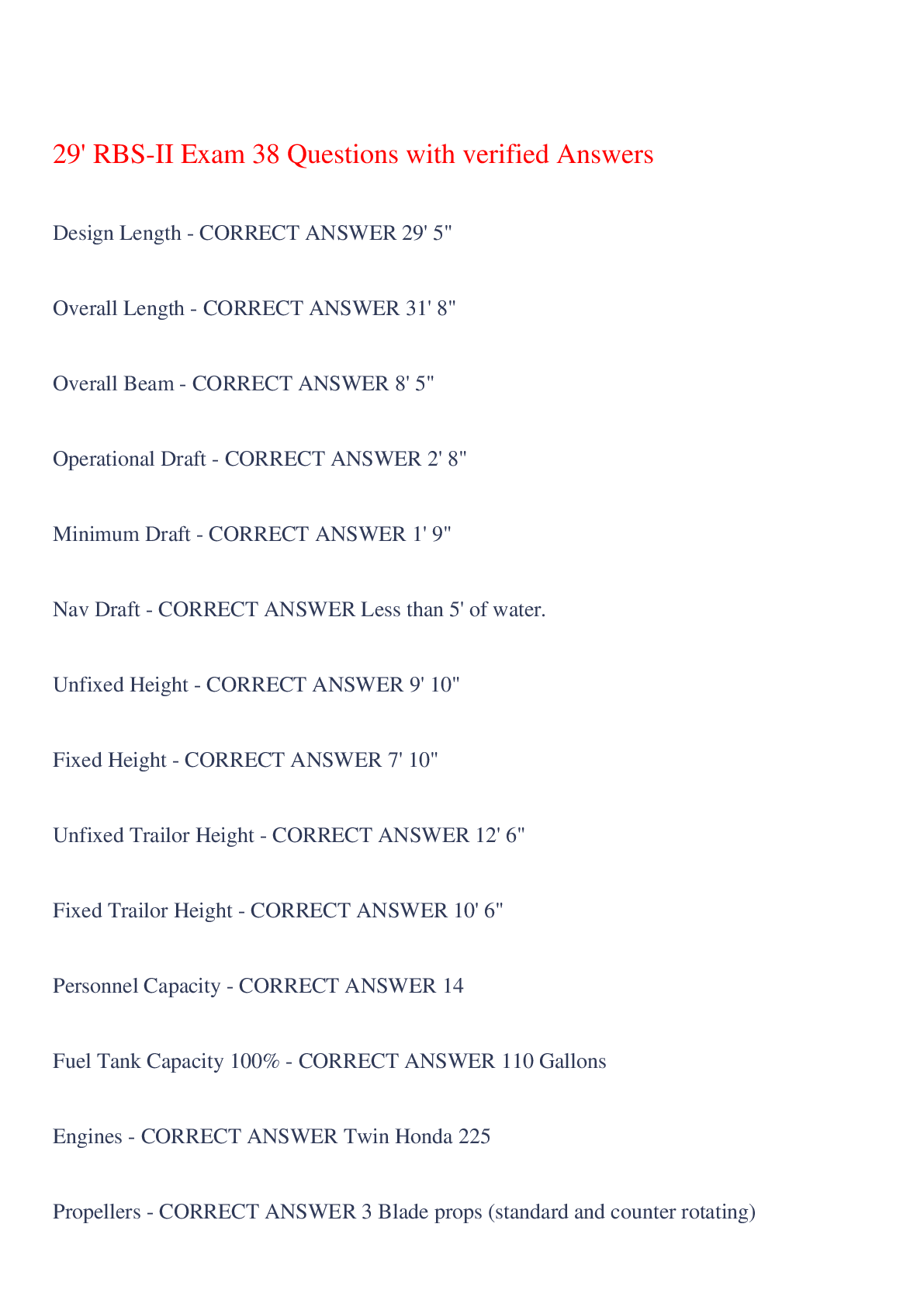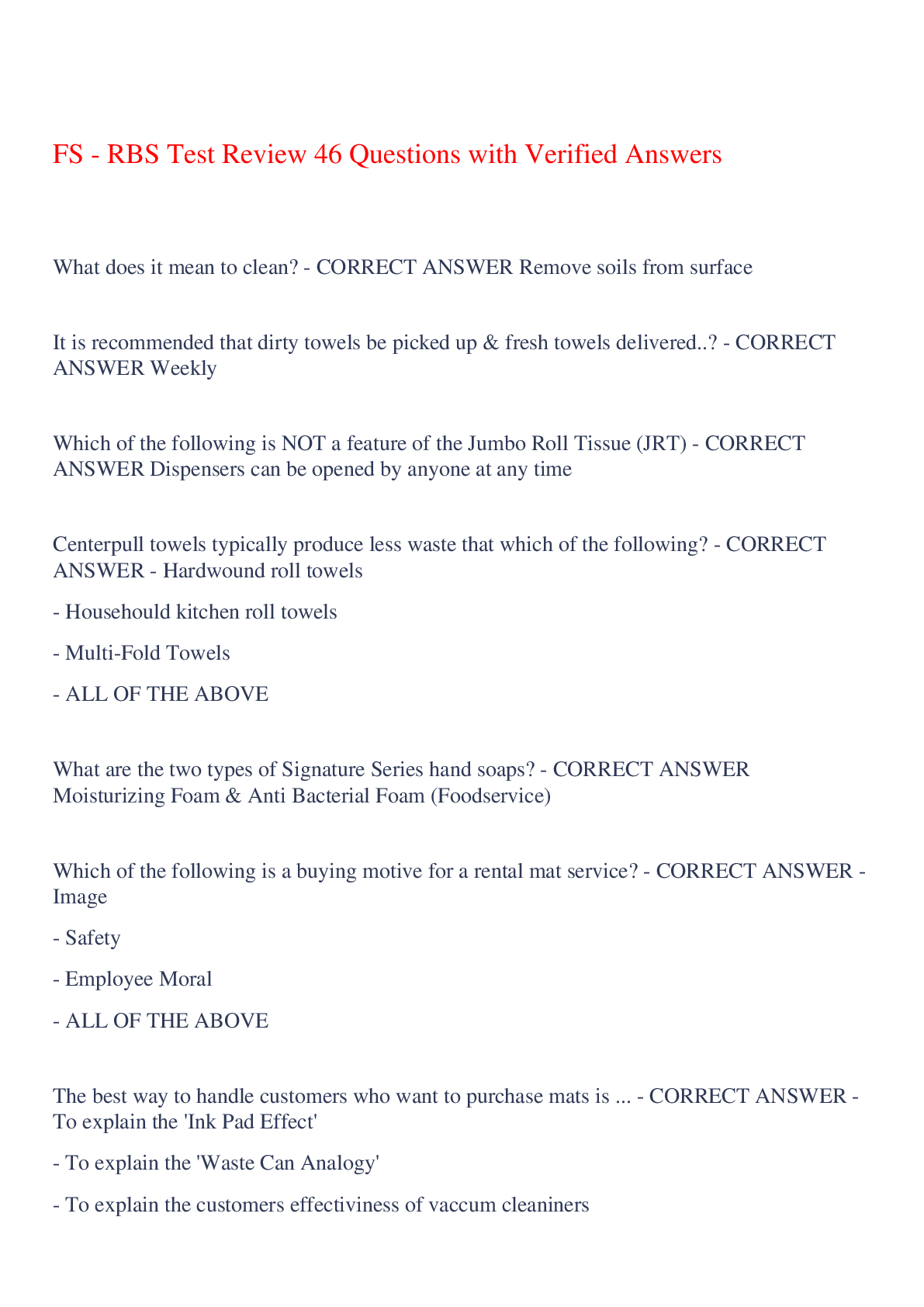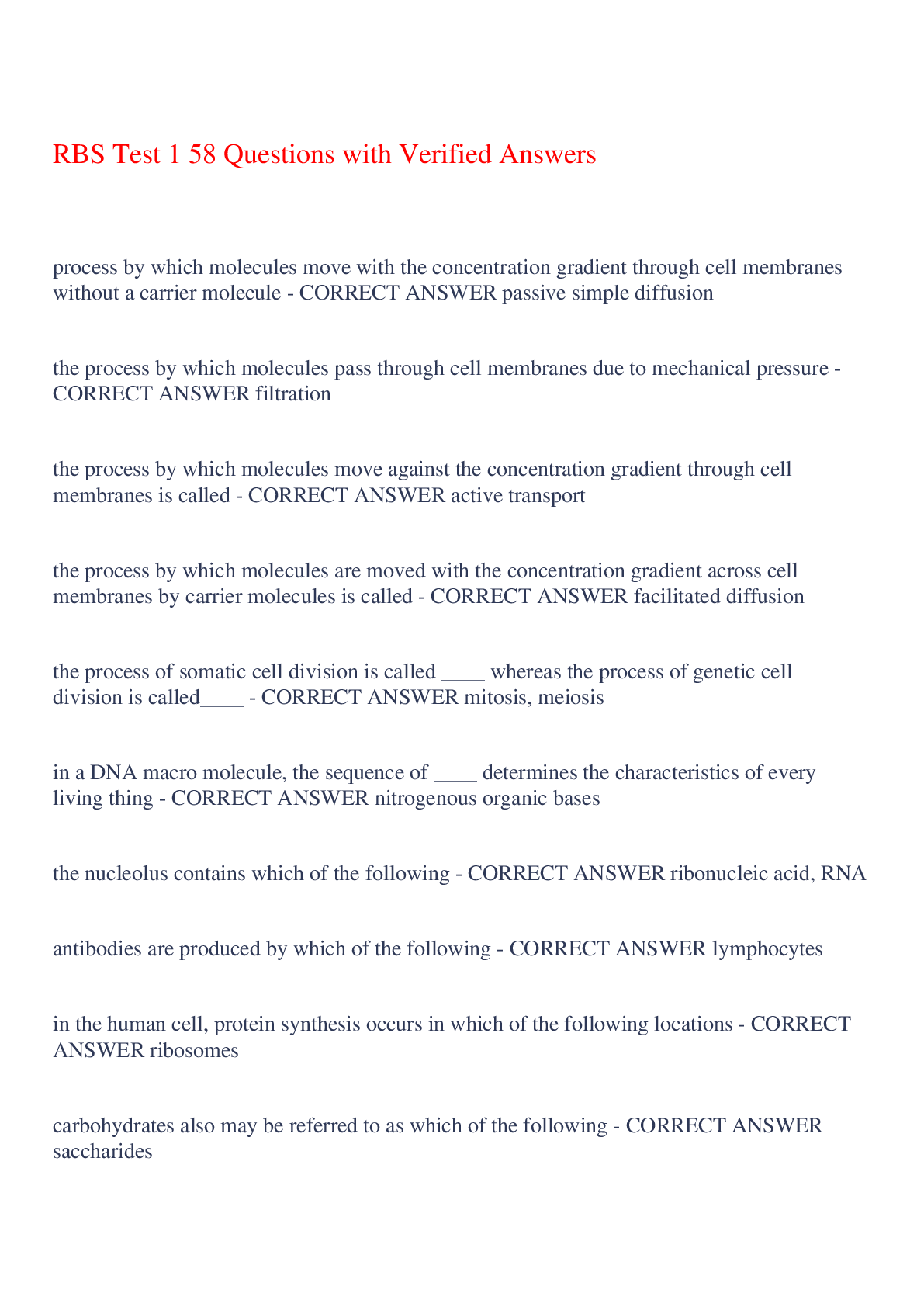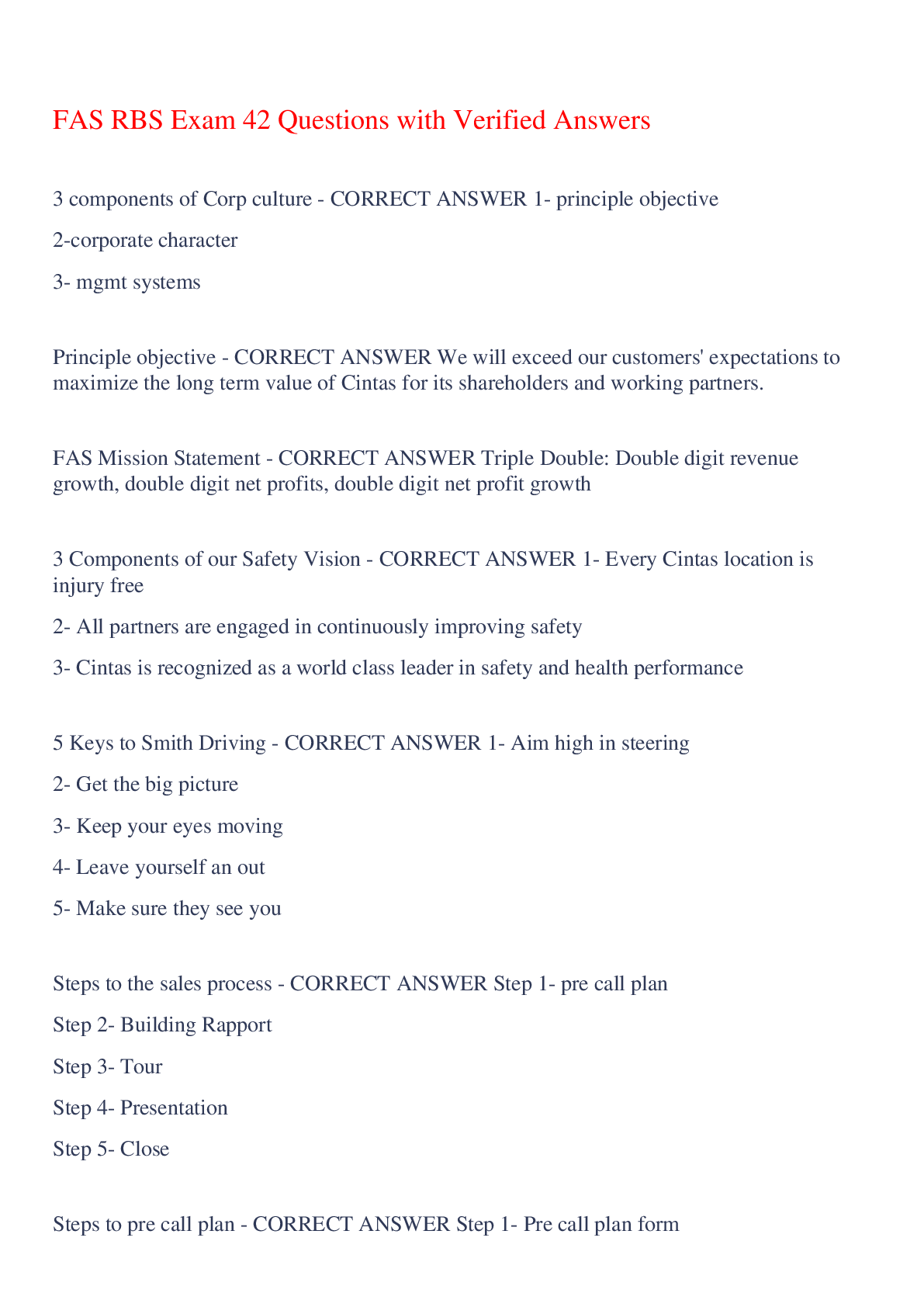CSE 1 Exam 45 Questions with Verified Answers,100% CORRECT
Document Content and Description Below
CSE 1 Exam 45 Questions with Verified Answers A) A respiratory therapist assigned to the coronary intensive care unit (CICU) is evaluating a post-op 74-year-old, 69 kg (152 lb.), 160 cm (5 ft., 3 i... n.) tall female patient who had mitral valve replacement surgery. The patient is intubated and one hour into a spontaneous breathing trial with PSV, FIO2 0.40, PS 5 cmH20, PEEP 5 cmH20. The patient is alert and resting comfortably. Which of the following should be recommended? (CHOOSE ONLY ONE unless you are directed to "Make another selection in this Section.") -Current Section -Simulation History -Attempt a T-piece trial -Obtain arterial blood gases and perform a physical assessment -Maintain the current settings and continue to observe -Set the pressure support at 0 and re-assess in 30 mins -Switch back to mechanical ventilation with pre-trial settings and re-assess in 24hrs -Extubate and administer supplemental oxygen at 40% - CORRECT ANSWERS -Obtain arterial blood gases and perform a physical assessment A) Which of the following should be assessed? -Respiratory exchange ratio -Exhaled Vt -VD/VT ratio -RR -pH of tracheal aspirate -HR -Intrapulmonary shunt (Qs/Qt) -BP -ECG via cardiac monitor -SpO2 -General appearance -Optimal compliance -Breath sounds -Peripheral pulses -Color - CORRECT ANSWERS -Exhaled Vt -RR -HR -BP -ECG via cardiac monitor -SpO2 -General appearance -Breath sounds -Color B) A respiratory therapist is asked to assess a 61-year-old, 73 kg (160 lb.), 180 cm (5 ft., 11 in.) tall male who was just admitted to the ED for acute exacerbation of COPD. The patient is currently receiving oxygen via nasal cannula at 2 L/min. During assessment, it is noted that the patient is febrile and in obvious respiratory distress. Vital signs are: heart rate 118/min, blood pressure 134/86 mmHg, and respirations 32/min. Chest auscultation reveals diffuse expiratory wheezes with coarse crackles throughout the left lower lung field. Which of the following should initially be recommended? -Mask CPAP 5 cmH20 with an FIO2 of 0.40 -35% oxygen via air-entrainment mask -Continue to closely monitor the patient's condition -Aerosol fluticasone (Flovent) treatment concurrent with PEP therapy -Oxygen at 12 L/min via nonrebreathing mask -Aerosol albuterol (Ventolin) - CORRECT ANSWERS -Aerosol albuterol (Ventolin) B) The physician asks for recommendations of diagnostic and lab studies to further assess the patient. Which of the following should be evaluated? -Ventilation-perfusion scan -Electrolytes -12-lead ECG -Sputum culture and sensitivity -P50 (measured) -Theophylline level -Carboxyhemoglobin level -Chest x-ray -RV/TLC ratio -ABG analysis -CT scan of the chest -CBC -Serum lactate level -Toxin screen -Upper airway x-ray - CORRECT ANSWERS -Electrolytes -Sputum culture and sensitivity -Theophylline level -Chest x-ray -ABG analysis -CBC C) A 27-year-old, 52 kg (115 lb.), 160 cm (5 ft., 3 in.) tall female patient is undergoing surgery for removal of a large mediastinal tumor. Following surgery, the patient is stabilized and transferred to the recovery room. You are asked to assist in the ventilator management of this patient while in the recovery room. After arriving in the recovery room, you would evaluate which of the following? -Position of ET tube -Ventilator settings -ECG via cardiac monitor -Urinary output -Breath sounds -Intracranial pressure -End-tidal CO2 -Bowel sounds -Blood pressure -Hemodynamic status -Heart rate -Respirations -Pulse oximetry (Sp02) -Ventilator alarm settings -Pupillary response - CORRECT ANSWERS -Position of ET tube -Ventilator settings -ECG via cardiac monitor -Breath sounds -End-tidal CO2 -Blood pressure -Hemodynamic status -Heart rate -Respirations -Pulse oximetry (Sp02) -Ventilator alarm settings C) You now obtain an ABG and the results are pH 7.35, PaCO2 43, HCO3 23, PaO2 139, SaO2 99%. The physician asks for your next recommendation. Which of the following would you suggest? -Maintaining current therapy -Lowering the FiO2 to 0.50 -Implementing PEEP at 5cmH2O -Increasing the inspiratory pressure to 14cmH2O -Increasing the ventilator rate to 14/min -Administering sodium bicarbonate - CORRECT ANSWERS -Lowering the FiO2 to 0.50 D) You are a respiratory therapist working in a respiratory clinic. A 48-year-old male with a history of COPD and a 21 pack year smoking history presents to the clinic with complaints of increasing shortness of breath on exertion of 6 months duration. To evaluate the patient's shortness of breath on exertion, you would recommend which of the following? -Performing oximetry during sleep -Simulation History -Performing an exercise thallium stress test -Performing cardiopulmonary exercise testing -Obtaining a ventilation-perfusion scan -Obtaining a resting 02 consumption -Performing cardiac stress testing - CORRECT ANSWERS -Performing cardiopulmonary exercise testing D) Which of the following would be appropriate to assess and/or evaluate during the patient's exercise test? Simulation History Airway resistance 02 consumption Body temperature Vital capacity Pulse oximetry (Sp02) Respirations ECG Central venous pressure (CVP) Work load Heart rate Blood pressure Arterial blood gases Maximum inspiratory pressure CO2 production Tidal volume - CORRECT ANSWERS 02 consumption Pulse oximetry (Sp02) Respirations ECG Heart rate Blood pressure Arterial blood gases CO2 production Tidal volume E) A respiratory therapist is reporting for work and assigned to the ICU. Shortly after arriving in the ICU, the therapist is asked to assist in transporting an intubated, mechanically ventilated, post-op blunt chest trauma adult male patient from the recovery room to the ICU. The patient is transported to his room in the unit without incident. When the therapist connects the patient to the ventilator, the low pressure alarm on the ventilator activates. Which of the following actions would be appropriate at this time? Current Section Simulation History Auscultate the patient's chest Set the F102 at 1.0 and assess the patient/ventilator system Disconnect the patient from the ventilator and manually ventilate Increase the inspiratory flow setting Adjust the low pressure alarm setting Increase the mandatory rate setting - CORRECT ANSWERS Disconnect the patient from the ventilator and manually ventilate E) The nurse is now manually ventilating the patient while the therapist inspects the ventilator. Which of the following should the therapist do and/or evaluate? -Simulation History -Check the ventilator tubing for kinks -Check the integrity of the endotracheal tube's cuff -Analyze the ventilator FIO2 -Check the oxygen and air line pressure -Tighten all ventilator circuit connections -Check all ventilator settings and alarms -Measure the peak inspiratory flow -Occlude the Y and activate the ventilator - CORRECT ANSWERS -Check the integrity of the endotracheal tube's cuff -Tighten all ventilator circuit connections -Check all ventilator settings and alarms -Occlude the Y and activate the ventilator F) You are an evening shift respiratory therapist reporting for duty and assigned to the ICU. During report, you are informed that the patient in bed 4 is an intubated, mechanically ventilated 60-year-old, 67 kg (148 lb.), 180 cm (5 ft., 11 in.) tall male who was admitted to the ICU 3 days prior due to respiratory failure secondary to exacerbation of COPD. The reporting therapist tells you that a spontaneous breathing trial had been attempted earlier in the day, but the patient did not tolerate the change in therapy. Mechanical ventilation had been re-instituted with the following settings: VC-A/C, rate 8/min, tidal volume 500 ml, FIO2 0.30, and PEEP 5 cmH20. After arriving in the ICU, you would assess and/or evaluate which of the following? -Ventilator tubing compliance -Heart rate and blood pressure -Peripheral reflexes -Urine output -Chest x-ray -12-lead ECG -ECG via cardiac monitor -Arterial blood gases -Characte - CORRECT ANSWERS -Heart rate and blood pressure -Chest x-ray -ECG via cardiac monitor -Arterial blood gases -Character of respiratory secretions -Position of endotracheal tube -Ventilator alarms -Ventilator settings -Breath sounds G) You are a respiratory therapist assigned to the pediatric intensive care unit (PICU) of a 500-bed community hospital. One of your patients is a 9-year-old, 29 kg (64 lb.), 119 cm (3 ft., 11 in.) tall female admitted three days prior for community-acquired pneumonia (CAP). She is currently receiving IV antibiotics and oxygen via 28% air-entrainment mask. When you arrive in the patient's room, you find her restless and agitated. You would assess and/or evaluate which of the following? -Breath sounds -ECG via cardiac monitor -Pulse and blood pressure -Arterial blood gas analysis -CBC -Chest x-ray -Maximum inspiratory pressure -Response to painful stimuli -General appearance -Position of trachea -Maximum voluntary ventilation -BUN -Closing volume -Vital capacity -Respiratory rate and pattern - CORRECT ANSWERS -Breath sounds -ECG via cardiac monitor -Pulse and blood pressure -Arterial blood gas analysis -CBC -Chest x-ray -General appearance -Position of trachea -Respiratory rate and pattern H) A respiratory therapist assigned to the ICU is managing the cardiopulmonary care of a 43-year-old female patient diagnosed with ARDS secondary to sepsis and nosocomial pneumonia. The patient is intubated and receiving PC-A/C, FI02 1.0, mandatory rate 14, PIP 28 cmH20, PEEP 8 cmH20, 1-time 1.5 sec. A pulmonary artery (PA) catheter and an arterial line are in place. The physician requests assistance in evaluating the current clinical condition of the patient. Which of the following should be assessed and/or evaluated? CVP Heart sounds. Chest x-ray Calculated Qs/Qt PCWP Sensorium Cardiac Output Static compliance PAP Respiratory rate pH of tracheal aspirate Blood pressure Arterial blood gas analysis Heart rate Breath sounds - CORRECT ANSWERS CVP Chest x-ray Calculated Qs/Qt PCWP Sensorium Cardiac Output Static compliance PAP Respiratory rate Blood pressure Arterial blood gas analysis Heart rate Breath sounds I) You are a night shift respiratory therapist assigned to the ED of a 400-bed community hospital. At 3:15 A.M., the ED physician requests your assistance in assessing a 24-year-old male with dyspnea and a complaint of chest tightness who was brought to the ED by his brother. Which of the following would you assess and/or evaluate? Ability to swallow General appearance Bowel Sounds CBC Color of mucous membranes Breath sounds Familial history SpO2 Heart Sounds ABG Peak Expiratory Flow Vital Signs Chest X-Ray Medical History Ability to complete a sentence - CORRECT ANSWERS General appearance CBC Breath sounds SpO2 ABG Vital Signs Chest X-Ray Medical History Ability to complete a sentence I) Oxygen via nonrebreathing mask at 12 L/min is initiated. Admission arterial blood gas results on room air reveal pH 7.49, PaCO2 30 mmHg, HCO3 23 mEq/L, PaO2 54 mmHg. Which of the following would you now recommend? Inhaled salmeterol every 20 minutes for the first hour IV epinephrine Inhaled salbutamol every 20 minutes for the first hour Inhaled fluticasone every 20 minutes for the first hour IV aminophylline IV atropine - CORRECT ANSWERS Inhaled salbutamol every 20 minutes for the first hour I) Arterial blood gases are obtained and the results are: pH 7.31, PaCO2 57 mmHg, HCO3 24 mEq/L, Pa02 59 mmHg. On the basis of the arterial blood gas results and the patient's fatigued state, the ED physician orders a trial of noninvasive positive pressure ventilation (NPPV) and requests your recommendation for initial settings. Which of the following initial settings would you recommend? IPAP 15 cmH20; EPAP 3 cmH20; FIO2 1.0 IPAP 15 cmH20; EPAP 5 cmH20; FIO2 0.50 IPAP 10 cmH20; EPAP 3 cmH20; FI02 0.50 IPAP 8 cmH20; EPAP 8 cmH20; FIO2 0.80 IPAP 5 cmH20; EPAP 5 cmH20; FIO2 0.50 - CORRECT ANSWERS IPAP 10 cmH20; EPAP 3 cmH20; FI02 0.50 I) On the basis of your assessment, you would now recommend which of the following? Set the EPAP at 5 cmH2O and set the FIO2 at 0.40 Discontinue NPPV and administer oxygen via 50% air- entrainment mask Maintain current settings and continue to monitor Titrate the FIO2 downward to maintain a SpO2 > 92% Set the IPAP at 8 cmH20 and set the EPAP at 2 cmH20 Discontinue NPPV and initiate mask CPAP at 3 cmH20 - CORRECT ANSWERS Titrate the FIO2 downward to maintain a SpO2 > 92% J) A respiratory therapist is reporting for work and assigned to the ICU. Shortly after arriving in the ICU, the therapist is asked to assist in transporting an intubated, mechanically ventilated, post-op blunt chest trauma adult male patient from the recovery room to the ICU. The patient is transported to his room in the unit without incident. When the therapist connects the patient to the ventilator, the low pressure alarm on the ventilator activates. Which of the following actions would be appropriate at this time? Increase the mandatory rate setting Auscultate the patient's chest Set the FIO2 at 1.0 and assess the patient/ventilator system Adjust the low pressure alarm setting Increase the inspiratory flow setting Disconnect the patient from the ventilator and manually ventilate - CORRECT ANSWERS Disconnect the patient from the ventilator and manually ventilate J) The nurse is now manually ventilating the patient while the therapist inspects the ventilator. Which of the following should the therapist do and/or evaluate? Measure the peak inspiratory flow Check the integrity of the endotracheal tube's cuff Analyze the ventilator FI02 Check the ventilator tubing for kinks Check the oxygen and air line pressure Tighten all ventilator circuit connections Check all ventilator settings and alarms Occlude the Y and activate the ventilator - CORRECT ANSWERS Check the integrity of the endotracheal tube's cuff Tighten all ventilator circuit connections Check all ventilator settings and alarms Occlude the Y and activate the ventilator J) The heat moisture exchanger is replaced and mechanical ventilation is resumed without any further problems. Over the next 4 days, the patient's condition improves and he is extubated. He is currently receiving mask CPAP 7 cmH20 with an FIO2 of 0.40. During this last hour, the patient has become restless and agitated. The physician requests the assistance of the respiratory therapist in evaluating the patient. Which of the following should now be assessed and/or evaluated? Muscle tone Arterial blood gases General appearance Vital signs Respiratory pattern Breath sounds ECG via cardiac monitor Pulse oximetry (Sp02) - CORRECT ANSWERS Arterial blood gases General appearance Vital signs Respiratory pattern Breath sounds ECG via cardiac monitor Pulse oximetry (Sp02) K) You are an evening shift respiratory therapist assigned to the surgical floor of a 250-bed community hospital. During your evening rounds, you are called to evaluate a 47-year-old female patient with a 37-year history of myasthenia gravis. You are informed by the patient's nurse that the patient is complaining of increasing dyspnea, fatigue, and cough. After arriving in the patient's room, you would assess and/or evaluate which of the following? History of present illness Skin color Muscle strength Chest symmetry Corneal reflex Sensorium Pulse oximetry (Sp02) Vital signs History of past illnesses Facial muscle tone Diagnostic chest percussion Ability to swallow Maximum voluntary ventilation Character of cough Breath Sounds - CORRECT ANSWERS History of present illness Skin color Muscle strength Chest symmetry Sensorium Pulse oximetry (Sp02) Vital signs History of past illnesses Facial muscle tone Diagnostic chest percussion Ability to swallow Character of cough Breath Sounds L) You are a respiratory therapist working in a 350-bed community hospital. You have just received a page to come to the medical floor and assess a 77-year-old male patient who has a long-standing history of COPD. When you arrive in the patient's room, you would assess and/or evaluate which of the following? Muscle tone Pupillary response General appearance Vital signs Pulse oximetry (Sp02) Chest inspection Breath sounds Peripheral pulses Peripheral reflexes Respiratory pattern - CORRECT ANSWERS General appearance Vital signs Pulse oximetry (Sp02) Chest inspection Breath sounds Respiratory pattern M) A respiratory therapist is evaluating a 27-year-old male with a medical history of asthma and exercise-induced bronchospasm (EIB) who presented to the respiratory clinic for a scheduled appointment. His current medication is an albuterol rescue inhaler administered on an as needed basis. When questioned about his symptoms, the patient states he has been using his rescue inhaler 3-4 times per week during this past year and during this time he has had nocturnal shortness of breath and wheezing that interferes with his sleep 3 - 4 times per month. The therapist notes that the patient's medical record indicates he has had three unscheduled asthma visits for mild exacerbation over this last year. A PEF is obtained which shows a measurement of 470 L/min (74% of predicted). On the basis of this information, which of the following asthma severity classifications would be applicable? Moderate persistent asthma Mild persis - CORRECT ANSWERS Moderate persistent asthma M) As a result of the patient's frequent symptoms, he is prescribed treatment with a low-dose inhaled corticosteroid (ICS) of fluticasone 44 mcg at 2 puffs administered twice per day. During a follow-up visit two weeks later, the patient remains symptomatic and continues to frequently use his rescue inhaler. Which of the following should be assessed to evaluate the patient's current condition? ABG analysis Use of rescue inhaler Breath sounds Activities of daily living General appearance Pulse oximetry (Sp02) Complete pulmonary function testing Patient concerns and questions Known allergies - CORRECT ANSWERS Use of rescue inhaler Breath sounds Activities of daily living General appearance Pulse oximetry (Sp02) Patient concerns and questions Known allergies N) A respiratory therapist is assigned to the coronary intensive care unit (CICU). The patient in bed 6 is an 84-year-old, 78 kg (172 lb.), 183 cm (6 ft.) tall male with a history of coronary artery disease (CAD) who was admitted to the unit 4 hours prior following coronary artery bypass graft (CABG) surgery. The patient is intubated and receiving supplemental oxygen via 35% T-adapter. The physician requests assistance in evaluating the patient's readiness to be extubated. Which of the following should be assessed and/or evaluated? Maximum inspiratory pressure Response to painful stimuli Spontaneous tidal volume Arterial blood gases 12-lead ECG Pulse oximetry (Sp02) Chest x-ray Breath sounds Character of sputum Vital signs Pupillary response Sensorium - CORRECT ANSWERS Maximum inspiratory pressure Spontaneous tidal volume Arterial blood gases Pulse oximetry (Sp02) Chest x-ray Breath sounds Character of sputum Vital signs Sensorium O) A respiratory therapist is assigned to the cardiopulmonary care of a 56-year-old, 61 kg (134 lb.), 165 cm (5 ft., 5 in.) tall female patient who was intubated with initiation of mechanical ventilation 2 days prior secondary to post-op respiratory failure. The current ventilator settings are: VC-SIMV, FIO2 0.30, PS 8 cmH2O, mandatory rate 6/min, tidal volume 450 mL, PEEP 5 cmH20. The arterial blood gas results obtained two hours earlier are: pH 7.42, PaCO2 38 mmHg, HCO3 24 mEq/L, PaO2 87 mmHg, Sa02 96%. The current chest x-ray shows improved clearing with bilateral inflation. The patient is alert and oriented. Which of the following should be assessed to further evaluate this patient's current clinical condition? Repeat arterial blood gas analysis Pulse oximetry (SpO2) Heart rate Vital capacity Spontaneous tidal volume Spontaneous respiratory rate Breath sounds Blood pressure Lactic acid level Sensorium Maximum vo - CORRECT ANSWERS Pulse oximetry (SpO2) Heart rate Vital capacity Spontaneous tidal volume Spontaneous respiratory rate Breath sounds Blood pressure Sensorium Maximum voluntary ventilation Skin color P) A 30 weeks' gestational age, 1350 g, infant female with resolving respiratory distress syndrome (RDS) is currently intubated and receiving CPAP 4 cmH20 with an FIO2 of 0.60. During the last five minutes, the infant has become increasingly dusky with periods of apnea and bradycardia. Arterial blood gases are obtained and the results are: pH 7.11, PaCO2 67 mmHg, HCO3 19 mEq/L, PaO2 39 mmHg. Which of the following should be recommended? Set the CPAP at 6 cmH20 and set the FIO2 at 0.70 Set the FIO2 at 0.70 PC-A/C; FI02 0.60; PIP 20 cmH20; mandatory rate 40; PEEP 4 cmH20; I-time 0.4 sec PC-SIMV; FI02 1.0; PIP 30 cmH20; mandatory rate 30; PEEP 4 cmH20; I-time 0.2 sec Set the CPAP at 6 cmH20 PC-A/C; FI02 0.60; PIP 25 cmH20; mandatory rate 50; PEEP 4 cmH20; I-time 0.3 sec - CORRECT ANSWERS PC-A/C; FI02 0.60; PIP 20 cmH20; mandatory rate 40; PEEP 4 cmH20; I-time 0.4 sec P) Twenty minutes later, arterial blood gases are obtained and the results are: pH 7.36, PaCO2 38 mmHg, HCO3 20 mEq/L, Pa02 47 mmHg. Which of the following should be recommended? Maintain present settings Set the mandatory rate at 45 Set the FIO2 at 0.70 Sedate the infant and continue to monitor Set the PEEP at 5 cmH20 Set the PIP at 22 cmH20 - CORRECT ANSWERS Set the PEEP at 5 cmH20 P) During the next twenty-four hours, the infant's course of therapy remains uneventful. The physician now requests recommendations for data that would help to evaluate the patient's current clinical condition. Which of the following should be evaluated? Urinalysis Transillumination of the chest ECG via cardiac monitor Head ultrasound Arterial blood gas analysis Serum bilirubin Ventilator settings and alarms Breath sounds Vital signs 12-lead ECG Chest x-ray Heart sounds - CORRECT ANSWERS ECG via cardiac monitor Arterial blood gas analysis Ventilator settings and alarms Breath sounds Vital signs Chest x-ray Heart sounds Q) The labor and delivery (L&D) charge nurse has requested the assistance of the respiratory therapist in the delivery of an infant approximately 31 weeks' gestation. Which of the following supplies should the therapist ensure is available in case of need? Tonsil suction (Yankauer tube) Oropharyngeal airways One-inch tape Curved/straight laryngoscope blades Foam donut head rest Sizes 5-: 6-: 8-Fr. suction catheters Stylet 2.5- to 4.0-mm ID cuffed ET tubes Laryngoscope handles Resuscitator bag and mask Suction set-ups 2.5- to 4.0-mm ID uncuffed ET tubes - CORRECT ANSWERS Oropharyngeal airways One-inch tape Curved/straight laryngoscope blades Foam donut head rest Sizes 5-: 6-: 8-Fr. suction catheters Stylet Laryngoscope handles Resuscitator bag and mask Suction set-ups 2.5- to 4.0-mm ID uncuffed ET tubes Q) Which of the following resuscitative drugs should be available? Gentamicin Epinephrine Furosemide (Lasix) Sodium bicarbonate Atropine Lidocaine - CORRECT ANSWERS Epinephrine Q) Thirty minutes later, a male infant is delivered. He is immediately dried, orally suctioned, and placed under a radiant warmer. Which of the following should now be assessed and/or evaluated? Heart rate Lecithin/sphingomyelin ratio Weight Reflex irritability Muscle tone Chest excursion Transillumination of the chest Color Respiratory rate and pattern Arterial blood gas analysis Breath sounds Thoracic compliance 12-lead ECG Blood pressure Position of trachea - CORRECT ANSWERS Heart rate Weight Reflex irritability Muscle tone Chest excursion Color Respiratory rate and pattern Breath sounds Blood pressure R) A respiratory therapist is asked to assist the pulmonary specialist during a bronchoscopic procedure to diagnose, rule out, the presence of Pneumocystis Carinii Pneumonia (PCP) in a 42-year-old male with a history of AIDS. Which of the following supplies and equipment should be available during the procedure? An appropriately sized bronchoscope Vacuum system ECG machine with 12-lead monitoring Oxygen and related delivery equipment Transbronchial aspiration needles A chronotropic agent (atropine) A topical anesthetic (lidocaine) Resuscitation equipment Bronchoscopic light source Syringe for medication delivery Uncuffed ET tubes of various sizes Syringe for bronchoalveolar lavage Specimen-collection devices A vasoconstrictor for bleeding control Pulse Ox - CORRECT ANSWERS An appropriately sized bronchoscope Vacuum system Oxygen and related delivery equipment Transbronchial aspiration needles A chronotropic agent (atropine) A topical anesthetic (lidocaine) Resuscitation equipment Bronchoscopic light source Syringe for medication delivery Syringe for bronchoalveolar lavage Specimen-collection devices A vasoconstrictor for bleeding control Pulse Ox R) Which of the following should be assessed during the procedure? Lavage volumes Patient's subjective response to the procedure Site of biopsies Patient's respirations Patient's blood pressure Patient's level of consciousness Patient's vital capacity Patient's heart rate Medications administered FIO2 Patient's temperature Pulse oximetry (SpO2) - CORRECT ANSWERS Lavage volumes Patient's subjective response to the procedure Site of biopsies Patient's respirations Patient's blood pressure Patient's level of consciousness Patient's heart rate Medications administered FIO2 Pulse oximetry (SpO2) R) Following the bronchoscopic procedure, the patient is taken to the respiratory ward and placed in respiratory isolation. He is started on IV trimethoprim/sulfamethoxazole (TMP/SMX) and oral prednisone, 40 mg b.i.d. His vital signs are stable and his SpO2 is 94% while on 35% oxygen via air-entrainment mask. The results from the bronchoalveolar lavage revealed Pneumocystis carinii and the biopsy revealed Pneumocystis carinii as well as Cryptococcus neoformans. Which of the following should be recommended next? Discontinue oxygen therapy Add amphotericin B to the patient's treatment regimen Maintain current therapy and continue to monitor Obtain an induced sputum sample to test for the presence of acid-fast bacteria (AFB) Obtain an arterial blood gas sample Switch the patient from oral prednisone to IV methylprednisolone - CORRECT ANSWERS Add amphotericin B to the patient's treatment regimen R) Initially, the patient responded well to treatment. On hospital day 3, the patient develops a skin rash and experiences episodes of severe nausea and vomiting. His physician suspects that the patient is allergic to the sulfa in trimethoprim/sulfamethoxazole (TMP/SMX) and asks for a recommendation in an appropriate replacement drug. Which of the following should be recommended? IV clindamycin IV atropine IV pentamidine IV dapsone IV isoniazid - CORRECT ANSWERS IV pentamidine R) Over the next 4 days, the patient's condition improves significantly. He has tolerated therapy well and a follow-up chest x-ray shows resolution of the reticular opacification that was noted on the admission chest x-ray. An arterial blood gas is obtained while on oxygen at 1 L/min by nasal cannula, the results are: pH 7.38, PaCO2 40 mmHg, HCO3 24 mEq/L, PaO2 102 mmHg. The patient's physician asks for a recommendation of further therapy or support. Which of the following should be recommended? Discontinue oxygen therapy Discontinue IV pentamidine Switch the patient from oral prednisone to aerosol flunisolide (AeroBid) Discontinue all therapy Continue the present therapy - CORRECT ANSWERS Discontinue oxygen therapy R) During the next 7 days, the patient's course of therapy is uneventful. The patient is discharged on hospital day 14 and scheduled for follow-up in the hematology/oncology clinic for treatment of cutaneous and pulmonary Kaposi's sarcoma (KS). At this time, the patient's physician is concerned about the possible recurrence of PCP and would like to initiate a treatment regimen for prevention and suppression of PCP. Which of the following should be recommended to the physician? Oral TMP/SMX (20 mg TMP; 400 mg SMX); administered once every 6 hours Aerosolized pentamidine (300 mg); administered once every 4 weeks Aerosolized ribavirin (6 g/300 mL); administered via face mask while sleeping MDI flunisolide (2 puffs per treatment); administered 4 times a day Oral prednisone (20 mg); administered twice a day IV pentamidine (3 mg/kg); administered once a day - CORRECT ANSWERS Aerosolized pentamidine (300 mg); administered once every 4 weeks S) A respiratory therapist working in the respiratory care clinic is asked to assist the pulmonologist in evaluating a 34- year-old male who was referred to the clinic with a history of increasing hemoptysis. Which of the following should be assessed? Chief medical complaints Breath sounds Facial muscle tone Social history Past medical history Marital status Family history Deep tendon reflexes Vital signs hypertension. Palpation of abdomen General Appearance Condition or oral and nasal mucosa Color of lips and nail beds Height and weight Pulse oximetry (Sp02) Family history - CORRECT ANSWERS Chief medical complaints Breath sounds Social history Past medical history Vital signs General Appearance Height and weight Pulse oximetry (Sp02) Family history S) After the therapist reports the assessment findings to the pulmonologist, he requests recommendations of diagnostic and laboratory data that may be helpful to further evaluate the patient's condition and make a diagnosis. Which of the following should be evaluated? Sweat chloride test Coagulation studies CBC Blood culture and sensitivity Cardiac biomarkers ELISA and Western blot test Arterial blood gas analysis Echocardiogram Sputum culture and sensitivity Chest CT Scan Chest x-ray Bedside spirometry - CORRECT ANSWERS Sweat chloride test. Coagulation studies CBC Sputum culture and sensitivity Chest CT Scan Chest x-ray Bedside spirometry T) A respiratory therapist is asked to assess a 61-year-old, 73 kg (160 lb.), 180 cm (5 ft., 11 in.) tall male who was just admitted to the ED for acute exacerbation of COPD. The patient is currently receiving oxygen via nasal cannula at 2 L/min. During assessment, it is noted that the patient is febrile and in obvious respiratory distress. Vital signs are: heart rate 118/min, blood pressure 134/86 mmHg, and respirations 32/min. Chest auscultation reveals diffuse expiratory wheezes with coarse crackles throughout the left lower lung field. Which of the following should initially be recommended? 35% oxygen via air-entrainment mask Aerosol fluticasone (Flovent) treatment concurrent with PEP therapy Mask CPAP 5 cmH20 with an FIO2 of 0.40 Continue to closely monitor the patient's condition Oxygen at 12 L/min via nonrebreathing mask Aerosol albuterol (Ventolin) treatment - CORRECT ANSWERS Aerosol albuterol (Ventolin) treatment T) The physician asks for recommendations of diagnostic and laboratory studies to further assess the patient. Which of the following should be evaluated? P50 (measured) Carboxyhemoglobin level Arterial blood gas analysis Ventilation-perfusion scan Upper airway x-ray Sputum culture and sensitivity Electrolytes CT scan of the chest CBC Chest x-ray 12-lead ECG Toxin screen Theophylline level RV/TLC ratio Serum Lactate level - CORRECT ANSWERS Arterial blood gas analysis Sputum culture and sensitivity Electrolytes CBC Chest x-ray Theophylline level U) The respiratory therapist assigned to the ED is asked to evaluate and recommend care for a 7-year-old asthmatic female in acute respiratory distress who was brought to the ED by her mother. The mother states that the child has had a "bad cold and stuffy nose" for the last two days. Which of the following should the therapist assess and/or evaluate? Past medical history History of present illness Pulse oximetry (Sp02) Arterial blood gases Peripheral pulses Ability to swallow General appearance Home medications Breath sounds Chest inspection Peak expiratory flow (PEF) Character of cough and sputum production Ability to complete a sentence Vital signs Chest x-ray - CORRECT ANSWERS Past medical history History of present illness Pulse oximetry (Sp02) General appearance Home medications Breath sounds Chest inspection Character of cough and sputum production Ability to complete a sentence Vital signs V) A respiratory therapist assigned to a 12-bed neurological intensive care unit (NICU) is managing the cardiopulmonary care of a 31-year-old, 52 kg (115 lb.), 160 cm (5 ft., 3 in.) tall female patient who sustained severe trauma to the head, face, and chest during a mugging. An ICP line is present and the patient's intracranial pressure is 14 mmHg. The patient is nasally intubated and receiving mechanical ventilation. Current ventilator settings are: VC-A/C, FIO2 1.0, mandatory rate 14, tidal volume 400 mL, PEEP 5 cmH20. Arterial blood gases on these settings are: pH 7.31, PaCO2 47 mmHg, HCO3 23 mEq/L, PaO2 79 mmHg, Sa02 94%. Which of the following should be recommended? Maintain current settings and continue to monitor Set the mandatory rate at 16 Set the tidal volume at 500 mL Increase the inspiratory flow rate by 20 L/min Add an inspiratory pause of 1 second Set the PEEP at 10 cmH20 - CORRECT ANSWERS Set the mandatory rate at 16 V) Twenty minutes later, the patient's physician requests assistance in evaluating the patient's response to the ventilator adjustment. Which of the following should be assessed and/or evaluated? 12-lead ECG Intracranial pressure Breath sounds Pulse and blood pressure Maximum inspiratory pressure (MIP) Forced expiratory time Arterial blood gases Chest x-ray - CORRECT ANSWERS Intracranial pressure Breath sounds Pulse and blood pressure Arterial blood gases [Show More]
Last updated: 7 months ago
Preview 1 out of 32 pages
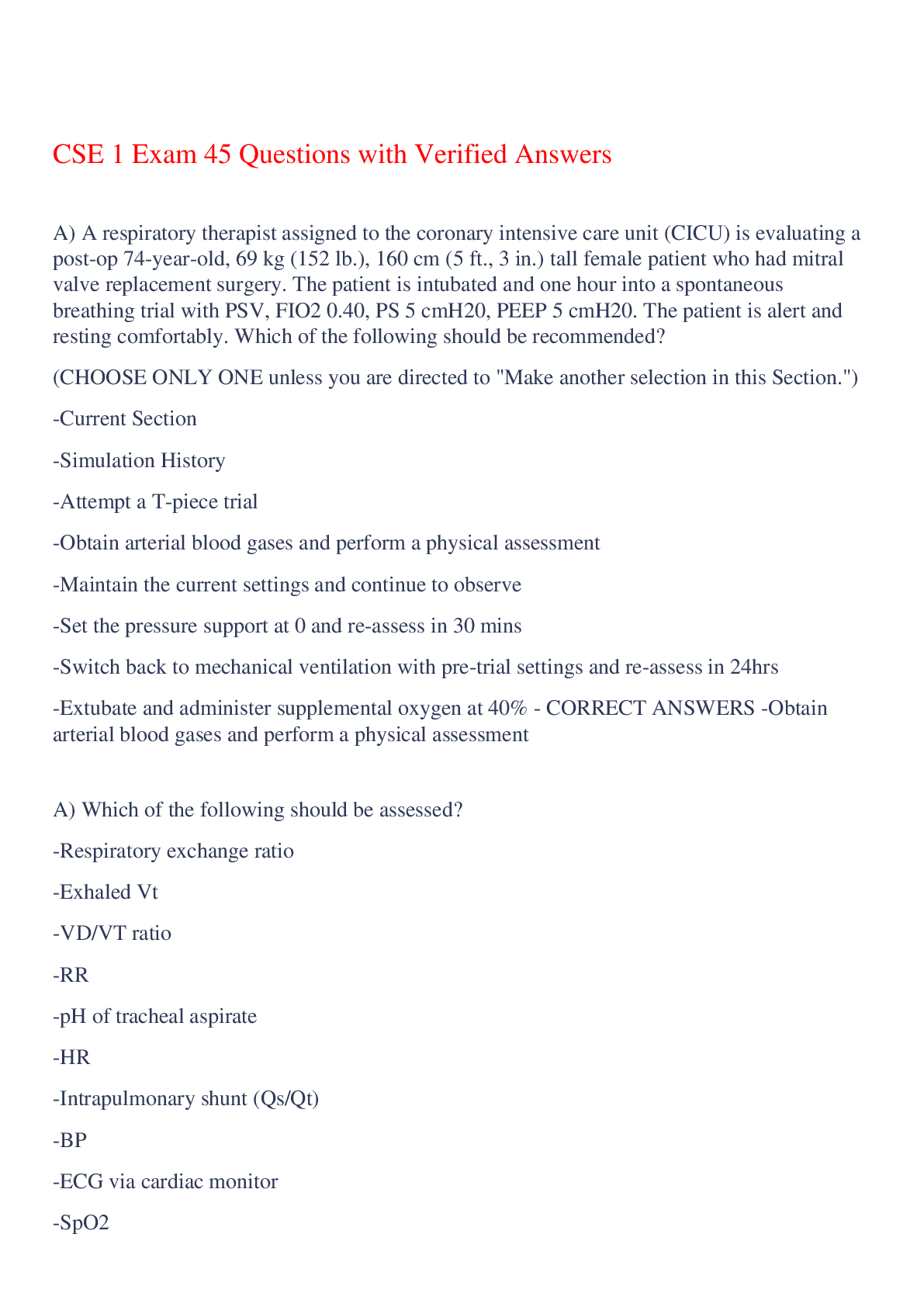
Buy this document to get the full access instantly
Instant Download Access after purchase
Add to cartInstant download
We Accept:

Reviews( 0 )
$8.50
Document information
Connected school, study & course
About the document
Uploaded On
Nov 19, 2023
Number of pages
32
Written in
Additional information
This document has been written for:
Uploaded
Nov 19, 2023
Downloads
0
Views
31













